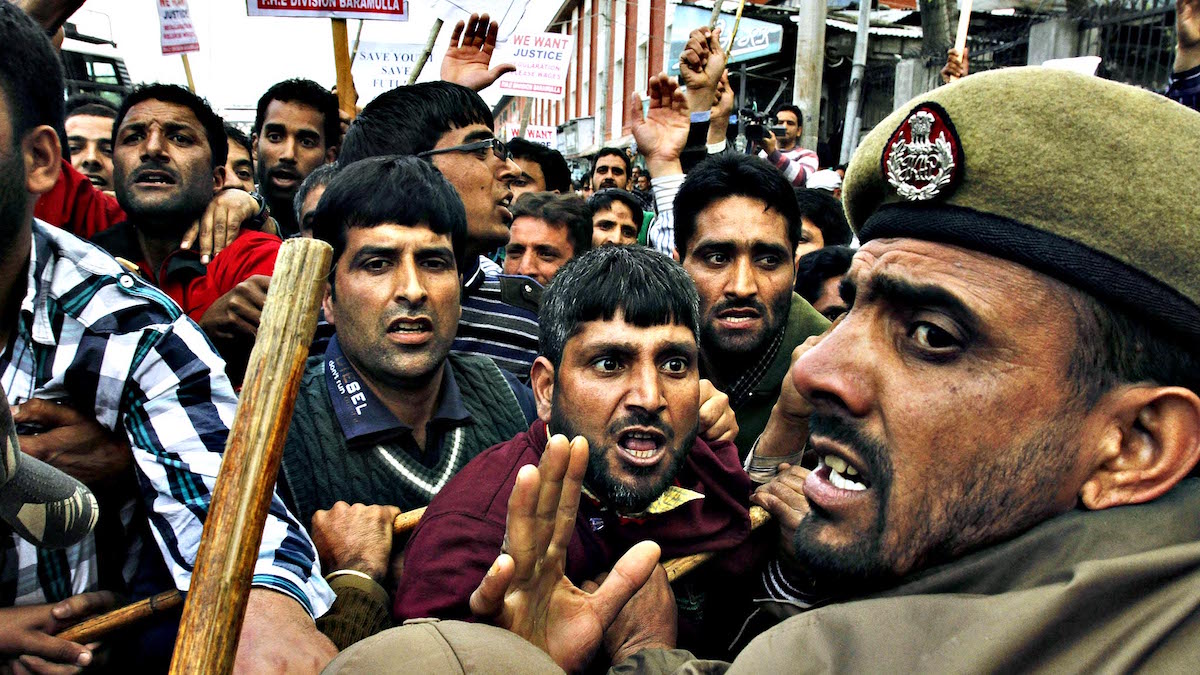This post is part of my wider History of India series. Today we look at the history of the Kashmir conflict and also answer the question of Why is Kashmir so important?
Why is Kashmir Important?

From a territorial dispute or political issue standpoint there are a lot of similar conflict in India. This has been the case ever since the independence of India. What makes the Kashmir conflict different? Why is Kashmir important?
Ultimately it is the people of Kashmir that solve the riddle for why is Kashmir so important. It is an important issue because of the costs and size of the human price sucked into this tragedy known as Kashmir. I
Kashmir is one of the most ethnically, religious, and linguistically diverse regions in all of South Asia. The people live in the middle of a conflict zone with attacks on either side of the conflict occurring on virtually a daily basis.
In the last two decades alone more than 40,000 people have been killed in the fighting, many of them civilians.
Human rights organizations routinely report on the findings of large swaths of unmarked graves in the territory of Kashmir. Kashmir is one of the most violent and dreadful places in the world today.
History of the Kashmir Conflict
In a previous post, I looked at the history and origins of the Kashmir conflict. We saw the rise of Sheik Abdullah, the betrayal between him and Nehru and the near chance for peace and resolution between India and Kashmir that was lost at the death of Nehru in 1964.
During that time and since the history of the Kashmir conflict has often served as a sort of stress relief between India and Pakistan. It is as if the two nations manage their tensions with one another in the regions of Kashmir so as to keep those tensions from boiling over into the whole of both countries.
This method seemed to work fine for a while until the people of Kashmir began standing up for themselves and altering the balance of these two powers. In this way in the history of the Kashmir conflict, the people of Kashmir themselves have helped in the destabilization. Even if India and Pakistan utilized Kashmir as a place to keep their conflict confined most of the time, that only meant that the people of Kashmir were in a constant state of stress and oppression as they were smashed between the two powers.
To review quickly, when the partition between India and Pakistan took place there were several states that wanted to pursue their own independent route. Most of them were persuaded otherwise in forceful terms by the Indian government.

The leader of Kashmir decided to take his chances and held out a neutral position until Pakistani forces invaded. In response he offered to join the new nation of India if they would protect him. Indian troops entered the territory and the first India-Pakistan war was on. India handily removed Pakistan from Kashmir and probably could have gone farther but Nehru opted to lean on the new United Nations to determine the fate of Kashmir.
The UN recommended a vote be made in Kashmir but then no one bothered to follow up to make sure that vote actually took place. As a result, Pakistan settled into certain regions of Kashmir and India into other regions – both with their militaries.
The new border was right in the heart of Kashmir and it was called the LOC or line of control.
History of the Kashmir Conflict – Occupation
In 1949 the Indian government voted and approved to give Kashmir its own internal autonomy. Kashmir would be part of India but could basically manage their domestic affairs on their own.

How this was to play out in reality on the ground was a matter of interpretation though and the two sides saw things differently.
Sheikh Abdullah was supposed to be India’s man in Kashmir. He was a Kashmiri but endorsed union with India. By way of an election that included creative vote counting, Sheikh Abdullah was elected leader of Kashmir and its special status.
It did not take long for Abdullah to begin to drift. By 1952 Abdullah was looking for full independent status in Kashmir. This was fine for some but not for all, specifically, it was not ok for those Hindu Kashmiris who still wanted union with India.
Eventually, Abdullah was arrested and imprisoned for refusal to fully endorse the Indian union and India put a new man in power in Kashmir. This was move was not popular among Kashmiris though and it did not last long.
With Sheikh Abdullah out of the way, Kashmir was incorporated as part of the Indian union, and as many had predicted, much of its special status began falling away. The Kashmiris began protesting and the political situation became so untenable for India that Sheikh Abdullah was finally returned to power in the early 1960s.
This, of course, is when the talks with Nehru were supposed to take place but when he died the trend of the Indian government to subvert any hints of Kashmiri sovereignty or special status continued.
History of the Kashmir Conflict – The Spreading of Tensions
After the 1965 war with Pakistan, two things began to happen. First, Sheikh Abdullah began losing all hope of a political resolution with India and he began reaching out for help to other political parties and powers. This included the Chinese and so, as a result, he was once again arrested by the Indian government in 1965. As the Kashmiris once again saw their leader and figurehead for independence unjustly imprisoned they began taking to the streets in protest. That is when the second thing happened and Pakistan began sending in guerrilla units to help stir up the protests and move them toward violence.

It did not take long for this to begin taking the shape of political terrorism.
As the 1970s dawned India was at the beginning of its rise toward the nation’s greatest achievements in democracy. That would be followed of course by the terrible fall from these heights beginning in 1975.
In the good years, efforts were made to correct the situation in Kashmir. A series of agreements were signed and the “special status” of Kashmir was restored along with Sheikh Abdullah who was returned to power after he agreed to and endorsed the special status.
This strange return to the status quo of twenty years earlier was too late though. The political impulses of terrorists had already been stirred. Radical voices were beginning to be heard out over more moderate and traditional voices like Sheikh Abdullah.
Then of course in the late 1970s, as India sank into its own political quagmire, Islamic fundamentalism and jihad were on the rise in Pakistan and Afghanistan. Their immediate goal was the expulsion of the Soviets out of Afghanistan but an Islamic state in Kashmir was also on their to-do list.
History of the Kashmir Conflict – A New Generation
In 1982 the great nationalist of Kashmir, Sheikh Abdullah, died and his son Faruq Abdullah was appointed to fill his place. The old patterns did not die though and Faruq himself was ousted by the Indian National Congress in 1984. This same pattern which had been repeated over and over again with Sheikh Abdullah would continue with his son Faruq and even today his grandson Omar continues in the futile steps.
The Abdullah family remains a figurehead of Kashmir politics but the Indian National Congress and the Indian government seems to have long since burned whatever bridges might have existed with Kashmir by way of these moderates.
The 1980s would hold much more history for the Kashmir conflict as it escalated into new heights of violence and protest.
As the Abdullahs were constantly moved in and out of office despite their pro-Indian union stance, the people of Kashmir quit hoping in politics and began taking to protest and opposition.
Once the Soviets were ejected from Afghanistan much of the arms and militant spirit that had been flowing through Pakistan and into Afghanistan now changed direction towards Kashmir.
As the protest grew larger and larger every year, the countermeasures of the Indian government also intensified. They began firing on protester frequently. Often a violent protest would result in even more violent responses from the Indian military.
When a group of more than 100 unarmed protesters was fired upon by the Indian military in 1990 the Kashmir conflict finally boiled over and became an insurgency of the entire population.

One month after this incident more than 400,000 people took to the streets in protest and demand for a vote for their nation’s independence – a vote they had been promised by the UN more than 40 years earlier.
One month after that the protests grew and continued to grow to more than 1 million Kashmiris marching in the streets.
The sudden surge of protests and escalation of their intensity throughout Kashmir caused a massive flight of much of the Hindu population in Kashmir who had traditionally been pro-Indian in their political positions.
As a simple result of these shifting demographics, in the 1990s the tone of the protests took on a much more Islamic militant tone. Arms and aid from Pakistan began flowing into Kashmir.
More than 10,000 youth were reported to have traveled across the border and into Pakistan for military training. The Indian military decided to fight fire with fire and began supporting their own proxy militias just like Pakistan was doing.
Pro-Indian militants could be seen roaming the countryside of Kashmir often taking out their revenge or frustrations on suspected Islamic militants.
The first decades of the 21st century would show even greater amounts of terrorism including an attack on the Indian parliament itself. Massacre after massacre has unfolded in Kashmir and the people themselves are lost in the conflict that seems to have no end.
Human Rights and the History of the Kashmir Conflict
At the turn of the 21st century, India had put more than 400,000 soldiers into Kashmir to enforce their will upon the land and its people. Every new deployment seems to bring with it new atrocities and new levels of resistance from the people of Kashmir themselves thus suggesting the whole matter is counterproductive.
Human rights organizations have documented widespread human rights abuses by the Indian military from arbitrary arrests to torture, rape, and massacre. The same is shown for the Kashmir resistance movements.
Aljazeera reports that since 1989:
- More than 70,000 people have been killed in the conflict
- More than 8,000 disappeared (which means likely kidnapped by one side or the other)
- More than 25,000 orphaned which means a likely new generation of disaffected protesters who will easily move to violence as they grow older
The people on both sides of the history of the Kashmir conflict are trapped in a cycle of violence and counter violence and they cannot escape. Each generation is sucked into this cycle and doomed to continue the futility as soon as they are born.
If you are enjoying this Backgrounder on the History of the Kashmir Conflict then you should check out my India Backgrounder. It features a full online series on the history of the world’s largest democracy along with podcast episodes and various explainers to give you an understanding of the current issues unfolding in India.





